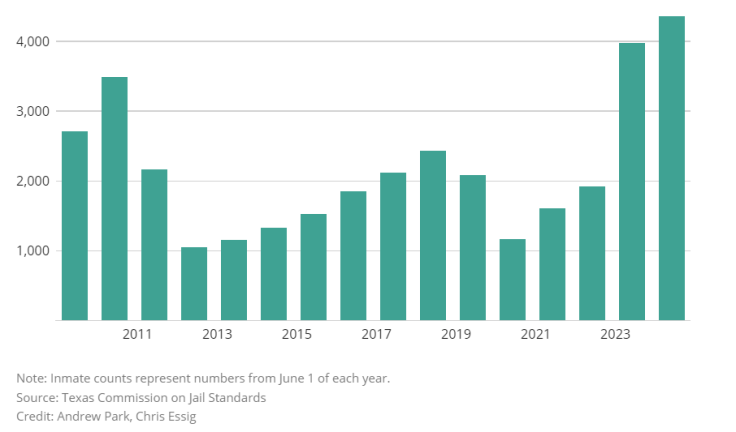
SEATTLE - Counties all across Texas are struggling to properly house the people held in their jails. One of the solutions taken by state authorities and lawmakers has been to use millions of tax dollars transporting inmates to either neighboring counties or across state lines.
The number of Texas inmates who were housed outside of their county of arrest increased from 2,078 in June of 2019 to 4,358 in June of 2024, according to a Texas Tribune analysis. Since the COVID-19 pandemic started, Texas has seen an exponential increase in the number of inmates housed elsewhere.

The number of counties relying on outsourcing has also risen. In June 2010, 31% of Texas county jails housed inmates elsewhere. In June 2024, 41% counties did so, according to data kept by the Texas Commission on Jail Standards.
Although violent crimes in Texas have decreased since 2020, overcrowding continues to be a problem in state jails and prisons. "It's very difficult to know exactly what is driving incarceration rates, but typically it's not crime rates," said Jeff Asher, a crime analyst, who cautioned against drawing a direct connection between the amount of crime in a community and the size of its jail population. "It's more about enforcement."
According to a recent report from the Prison Policy Initiative, Texas ranks among the top 10 states in the U.S. in terms of incarceration rates, as Texas locks up 751 individuals per 100,000 of residents. Louisiana tops the list of U.S. states with the highest incarceration rates, with 1,067 per 100,000 residents, according to the report.
The lack of jail cells as well as the need for jailers are some of the factors worsening the situation. In 2021, a state law limited who can be released while awaiting trial, increasing the number of people in jails and lengthening the amount of time they stay behind bars. The lack of personnel has also played its part, as fewer jailers means prisons and county jails have to lower the number of inmates they can hold, even if cells are available.
"Counties are having to think outside the box," said Ricky Armstrong, assistant director of the Texas Commission on Jail Standards. "We know there are some counties housing people out of state. It's not something we recommend or encourage, but we see that as a necessary evil."
Civil rights advocates and organizations argue that the state should heavily invest in mental health support and alternatives to incarceration. They also say the state should adjust its bail policies so decisions about who is freed until trial are not effectively based on an individual's wealth.
"We are addicted to carceral solutions," said Krish Gundu, co-founder of the Texas Jail Project, which advocates for people in Texas county jails. "If we really cared about not having these people in jails, you'd look at why they are ending up in jail and solve the problem at the root."
Since 2022, at least eight Texas counties — Sabine, Harris, Wilbarger, Newton, Chambers, Tyler, Loving and Liberty — have sent their overflow jail population out of state to Louisiana, Oklahoma, Colorado and Mississippi.
© 2024 Latin Times. All rights reserved. Do not reproduce without permission.







